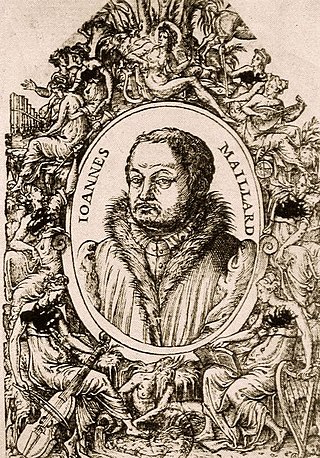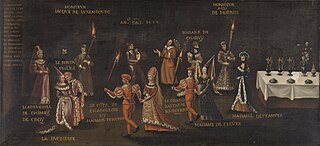Related Research Articles

In Western classical music, a motet is mainly a vocal musical composition, of highly diverse form and style, from high medieval music to the present. The motet was one of the pre-eminent polyphonic forms of Renaissance music. According to Margaret Bent, "a piece of music in several parts with words" is as precise a definition of the motet as will serve from the 13th to the late 16th century and beyond. The late 13th-century theorist Johannes de Grocheo believed that the motet was "not to be celebrated in the presence of common people, because they do not notice its subtlety, nor are they delighted in hearing it, but in the presence of the educated and of those who are seeking out subtleties in the arts".

Josquin Lebloitte dit des Prez was a composer of High Renaissance music, who is variously described as French or Franco-Flemish. Considered one of the greatest composers of the Renaissance, he was a central figure of the Franco-Flemish School and had a profound influence on the music of 16th-century Europe. Building on the work of his predecessors Guillaume Du Fay and Johannes Ockeghem, he developed a complex style of expressive—and often imitative—movement between independent voices (polyphony) which informs much of his work. He further emphasized the relationship between text and music, and departed from the early Renaissance tendency towards lengthy melismatic lines on a single syllable, preferring to use shorter, repeated motifs between voices. Josquin was a singer, and his compositions are mainly vocal. They include masses, motets and secular chansons.

Johannes Ockeghem was a Franco-Flemish composer and singer of early Renaissance music. Ockeghem was the most influential European composer in the period between Guillaume Du Fay and Josquin des Prez, and he was—with his colleague Antoine Busnois—the leading European composer in the second half of the 15th century. He was an important proponent of the early Franco-Flemish School.

Guillaume Du Fay was a composer and music theorist of early Renaissance music, who is variously described as French or Franco-Flemish. Considered the leading European composer of his time, his music was widely performed and reproduced. Du Fay was well-associated with composers of the Burgundian School, particularly his colleague Gilles Binchois, but was never a regular member of the Burgundian chapel himself.
In music, a cantus firmus is a pre-existing melody forming the basis of a polyphonic composition.

The Burgundian School was a group of composers active in the 15th century in what is now northern and eastern France, Belgium, and the Netherlands, centered on the court of the Dukes of Burgundy. The school inaugurated the music of Burgundy.

Antoine Busnois was a French composer, singer and poet of early Renaissance music. Busnois and colleague Johannes Ockeghem were the leading European composers of the second half the 15th century, and central figures of the early Franco-Flemish School.
Antoine de Févin was a Franco-Flemish composer of the Renaissance. He was active at the same time as Josquin des Prez, and shares many traits with his more famous contemporary.
Gaspar van Weerbeke was a Netherlandish composer of the Renaissance. He was of the same generation as Josquin des Prez, but unique in his blending of the contemporary Italian style with the older Burgundian style of Dufay.

Jean Maillard was a French composer of the Renaissance.
Matthaeus Pipelare was a Netherlandish composer, choir director, and possibly wind instrument player of the Renaissance.
France has a rich music history that was already prominent in Europe as far back as the 10th century. French music originated as a unified style in medieval times, focusing around the Notre-Dame school of composers. This group developed the motet, a specific musical composition. Notable in the high Middle Ages were the troubadours and trouvères soon began touring France, composing and performing many original songs. The styles of ars nova and ars subtilior sprung up in the 14th century, both of which focused on secular songs. As Europe moved into the Renaissance age, the music of France evolved in sophistication. The popularity of French music in the rest of Europe declined slightly, yet the popular chanson and the old motet were further developed during this time. The epicenter of French music moved from Paris to Burgundy, as it followed the Burgundian School of composers. During the Baroque period, music was simplified and restricted due to Calvinist influence. The air de cour then became the primary style of French music, as it was secular and preferred by the royal court.
In Renaissance music, the cyclic mass was a musical setting of the Ordinary of the Roman Catholic Mass, in which each of the movements – Kyrie, Gloria, Credo, Sanctus, and Agnus Dei – shared a common musical theme, commonly a cantus firmus, thus making it a unified whole. The cyclic mass was the first multi-movement form in western music to be subject to a single organizing principle.

The Feast of the Pheasant was a banquet given by Philip the Good, Duke of Burgundy on 17 February 1454 in Lille, now in France. Its purpose was to promote a crusade against the Turks, who had taken Constantinople the year before. The crusade never took place.
Nuper rosarum flores, is a motet composed by Guillaume Dufay for the 25 March 1436 consecration of the Florence Cathedral, on the occasion of the completion of the dome built under the instructions of Filippo Brunelleschi. Technically, the dome itself was not finished until five months later, at which time a separate consecration was celebrated by Benozzo Federighi, the bishop of Fiesole, substituting for the newly appointed archbishop of Florence, Cardinal Vitelleschi.
The motet-chanson was a specialized musical form of the Renaissance, developed in Milan during the 1470s and 1480s, which combined aspects of the contemporary motet and chanson.
Johannes de Quadris (Quatris) was an Italian composer of the early Renaissance. He was one of the first composers of polyphony associated with the basilica of St. Mark's in Venice, and the earliest known composer to write a polyphonic setting of the Magnificat for four voices.

Jheronimus Vinders was a Franco-Flemish composer of the Renaissance, active at Ghent. He was a minor member of the generation after Josquin des Prez, and he also composed a notable lament on the more famous composer's death.
Vasilissa ergo gaude is an isorhythmic motet by the Renaissance composer Guillaume Dufay. In terms of its subject matter, it is sometimes grouped together with Lamentatio sanctae matris ecclesiae Constantinopolitanae, Apostolus gloriosus and Balsamus et munda cera which are generically called Dufay's Byzantine motets. Its composition was occasioned by the marriage on 21 January 1421 of Cleofa Malatesta, daughter of Malatesta di Pandolfo, to Theodore II Palaiologos, son of the Byzantine emperor Manuel II and Despot of the Morea. It has been surmised that the actual motet was composed in 1420 and is perhaps the earliest example of this choral form if not the earliest work attributed to Dufay. In earlier scholarship it was assumed that the motet's first performance had taken place on May 19, 1419, during the festivities prior to the marriage
Dominique Vellard is a French tenor and specialist in medieval music. In 1979 he founded the Ensemble Gilles Binchois, a leading ensemble in the performance of Ars Nova music. He is also a composer.
References
- ↑ Modern edition: Besseler, Heinrich (ed.): Guilleelmi Dufay Opera Omnia, vol. VI: Cantiones. (=Corpus mensurabilis musicae, 1). Rome: American Institute of Musicology, 1964. p. xxviii-xxix, 19–21.
- ↑ Margaret Vardell Sandresky, "The Golden Section in Three Byzantine Motets of Dufay", Journal of Music Theory, Vol. 25, No. 2 (Autumn, 1981), pp. 291-306
- ↑ Hans Kühner, "Ein unbekannter Brief von Guillaume Dufay", Acta Musicologica, Vol. 11, Fasc. 3 (Jul. - Sep., 1939), pp. 114-115
- ↑ Sandresky, Margaret Vardell: The golden section in three Byzantine motets of Dufay. Journal of Music Theory 25 (1981): 291-306.
- 1 2 Devereaux, Rima: Reconstructing Byzantine Constantinople: intercession and illumination at the court of Philippe le Bon. French Studies 59.3 (2005): 297–310.
- ↑ Spechtler, Franz Viktor: Lyrik des ausgehenden 14. und des 15. Jahrhunderts. Rodopi, 1984, p. 156
- ↑ Edmund A. Bowles, Instruments at the Court of Burgundy (1363-1467), The Galpin Society Journal, Vol. 6, (Jul., 1953), pp. 42-43
- ↑ Whitwell, David: On music of the courts of Burgundy. [www.whitwellessays.com/docs/DOC_565.doc]
- ↑ Alberto Gallo, translated by Karen Eales: Music of the Middle Ages II. Cambridge: Cambridge University Press, 1985. p. 104, proposes it was written a year later; Spechtler (op.cit.) merely states the time and context of its composition is unknown.